In the local mountains of Fukuoka Prefecture, Kyushu, Japan, there exists two miniature orchid plants that literally spend their lives hanging off the the edge of branches or even twigs of trees – most notably Japanese plum yew, Cephalotaxus harringtonia, Japanese cedar, Cryptomeria japonica. and to a lesser extent, hinoki cypress, Chamaecyparis obtusa. Mind you, these trees grow on exposed ridge lines that commonly experience typhoons (the Eastern equivalent of hurricanes) and near constant winds off the sea. Such a life is precarious to say the least, yet they manage to thrive. Both are closely related, but in different genera.

Thrixspermum japonicum is a miniature evergreen epiphytic orchid. The plant grows from one growing point (monopodial growth form) and has a trailing stem. Offshoots can grow off this stem, sometimes forming small clumps of pendulous growths. The entire plant is small with each growth being 3-10 cm in length, occasionally longer in really large specimens. The thin leaves are usually a deep purplish green, between 1-3.5 cm long and 0.5-1 cm wide. The light grey-green roots mostly grow off the leafless end of the stem and are 4-9 mm long and about 1 mm wide. The flower buds begin to form in late summer in small clusters, and stay in stasis throughout the winter months until opening in mid spring.
The flowers hang in clusters of 3-8, hanging neatly arrayed with all the flowers facing the same way. Each flower is tiny, not much more than 1 cm across and is a lovely creamy yellow. The flower is cupped forward, but mostly open, however the dorsal sepal stays bent forward over the lip. The sepals and petals are pure creamy yellow. The lip is heavily marked with reddish brown and is bulbous at its base with two flaring up swept “wings” at its sides. The seed pods are elongate and thin; 2-2.5 cm long and about 3 mm wide. Plants typically form small, loose colonies.

This species is locally abundant in wet forests growing on the twigs and small branches of conifer trees, especially Japanese cedar, Cryptomeria japonica, and Japanese plum yew, Cephalotaxus harringtonia. White it is also reported to grow on the trunks of evergreen broad leafed trees such as the Camphor tree, Cinnamomum camphora, I have not seen that locally. Plants tend to grow at fairly high elevations, from 400 m to 1000 m. They have been collected from Iwate Prefecture in the north of Honshu and all the way southward to Kyushu, Shikoku, and Yaku Island off the Kyushu’s southern coast.
This was the first epiphytic Japanese orchid I ever saw in the wild. I was a bit surprised to find it, especially where I found it. It was growing on the very outermost branches of a Cephalotaxus tree high up a mountain where winters get quite cold. Since then I’ve seen many more, with the vast bulk of these being on the forest floor attached to fallen twigs and branches. If this orchid had a job description it would read, “dangling precariously on small twigs high up in trees and falling to the ground” – and that is about the truth! I am constantly finding plants on the ground during my outings into the mountains. Whenever I see a recently fallen cedar branch, I always give it a close look.
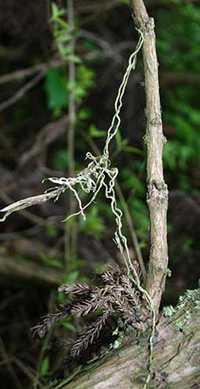
The plants don’t seem to last long once they’ve made their vertical journey to the earth. I’d imagine they don’t last more than a year or so, and then give in to the damp and dankness of the wet earth. It is not uncommon to see dead plants on old branches that fell a year or more before. I collect all I find. Despite its small stature, this is a lovely little plant. If it were even twice its size it would be considered an outstanding species. Maybe that is a blessing in disguise since it no doubt would also be more subject to collection. It doesn’t seem to need old growth forests to survive since I’ve found it on fairly young cedar trees in plantation forests.
There isn’t much information about growing these in cultivation, though all the local orchid growers have said they are hard to maintain long term. They are sometimes sold at local shows and these are no doubt ones that fell from their twiggy homes. I’ve grown a few for several years now, and they are remarkably hardy plants, but a bit tricky to keep in the long haul. The big issue with these is giving them plenty of humidity, bright light, and short periods of drying between watering. They are very cold hardy as well, capable of handling temperatures well below freezing for long periods of time. I’d say they can handle USDA cold hardiness zone 8b with no problem provided the summers are warm.

Gastrochilus matsuran, like its relative is a miniature evergreen epiphytic orchid. It too is monopodial in habit and can form clumps, but they are even more dwarf than the preceding species. The entire plant is tiny with each growth being only 2-5 cm in total length. The fleshy leaves are a deep to light green, lightly or heavily spotted with dark purple, and tend to curve downward in clusters. Each is 5-25 mm long and 3-7 mm wide. The light grey-green roots can grow off the stem at any point, but most are at the leafless end and are between 5-7 mm long and about 1 mm wide.
The flower buds begin to form in late summer in small clusters, and as with T. japonicum they stay in stasis throughout the winter months until opening the following spring. The flowers hang in clusters of 3-8 pointing in any given direction, but always away from the plant. Each flower is no more than 1 cm across and has the same basic colors as the leaves. The flower is cupped with the sepals and petals being mostly bright green. The lip is bright green and heavily marked with deep purple, bulbous at its base with two flaring “wings” at its end. Pure green and white forms exist as well. The seed pods are large, perhaps twice the size of the flowers, elongate, but fat and ribbed. They have the same color pattern as the rest of the plant.
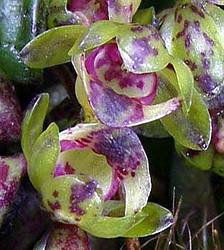
They are found in wet forests, often alongside T. japonicum, on the twigs and small branches of conifer trees, especially Japanese cedar, Cryptomeria japonica, and hinoki cypress, Chamaecyparis obtusa. On occasion you can see them on evergreen broad leafed trees, growing on the main trunk. They are always found at higher elevations and usually in old growth forest, 500 m or higher.
This little twig epiphyte is somewhat of a rarity in Japan these days in comparison with its relative T. japonicum, maybe because it prefers old growth forests. However, they are commonly seen growing side by side. In these forests the plants grow high off the ground, dangling precariously from the smallest branches and twigs of the trees. G. matsuran, despite its preference for conifers, can also be found growing on the trunks of hardwoods in thick layers of moss and lichens. Here it can form luxurious colonies with many growth clumps.
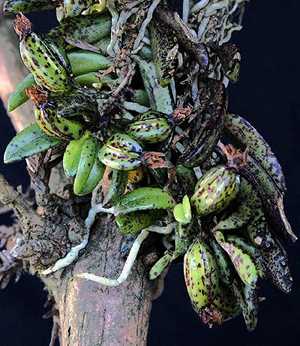
Given the elevations they grow at and the exposed position of their habitat, they are remarkably hardy little plants. In the winter frozen fog, snow, freezing rain, sleet, and hail are frequent at these altitudes and they take the brunt of it. Likewise, temperatures at this altitude can swing down to less than -5 C or lower on a regular basis and remain around freezing for weeks on end. In late summer typhoons rip through these forests perched high up on mountainsides with winds exceeding 50 m/sec. Summer temperatures frequently exceed 30C and rarely fall below 26C. All of this they somehow remarkably endure. Having said that, they do require high humidity, strong light, and lots of airflow to live and prosper.
The color scheme of this plant is kind of comical since every part of the plant is green with purple spots except the roots. The fat little leaves too are unique. They give the impression of bunches of little green and purple bananas hanging off a twig. Truly another cool little orchid.

There isn’t much information about growing these in cultivation. The first plants I ever saw were ones I found on the ground in April 2006. They were on a cedar branch along with several plants of T. japonicum. I took them since they’d die on the wet forest floor from rot and lack of light. The plants flowered nicely for me and have since grown new leaves and roots. They don’t appear to require anything special except bright light, watering that allows for drying out, and good air movement. Based on what I’ve seen, I wouldn’t try growing them in pots. While other growers I’ve talked to say they have a hard time keeping them going, I have had good luck with my rescued friends.
Here are two lovely, yet tiny, epiphytes that can withstand pretty brutal conditions so long as they get enough humidity and air movement. Both should be amenable to greenhouse culture or a warm, humid climate in the outside garden. Neither will win awards for the most spectacular flower, but they surely can win your heart when you see them in person.
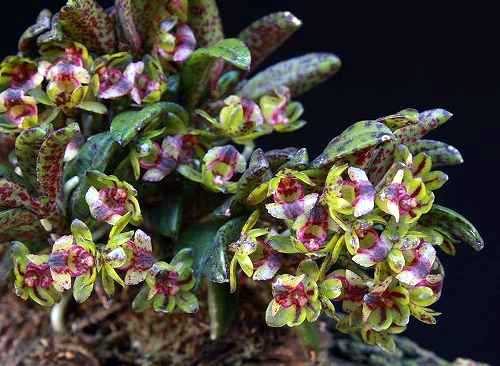
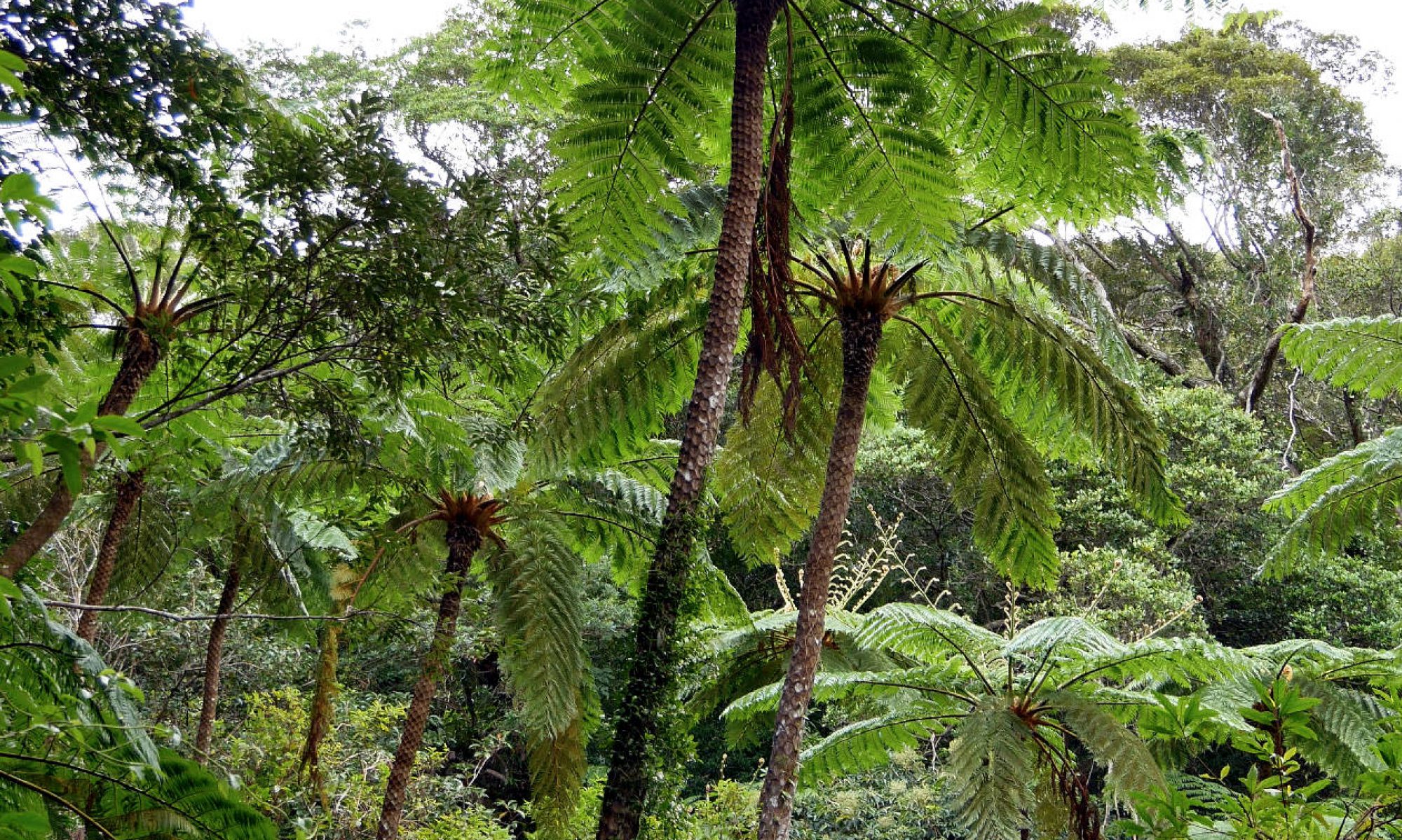
These species really tickle my fancy in a very well presented article Well Done !!
Hey Raymond,
Thanks! Too bad both are rare in cultivation. The sad truth is that both G. matsuran and T. japonicum are hard to maintain long term, especially the latter plant. I’ve watched individuals of T. japonicum over a 5 year period and have come to the conclusion that most do not live longer that a decade or so in the wild, and rarely grow more than one fan of leaves. G. matsuran on the other hand can form impressive clumps over time and at one location the plants seem to be very stable. The same holds for plants I’ve grown at my house – T. japonicum wax and wane quickly while G. matsuran just chugs along, slowly getting bigger each season.
In the future I’ll post an article about their tiny relative, Gastrochilus toramanus, another miniature 2/3 the size of G. matsuran and a true rarity, being an endemic to just a few regions of southern Japan.
Thank you Kind Sir for your reply. I will search for such plants here in Australia and see what I can do with them ( if I can find any ) Meanwhile keep up the good work, Your articles are full of interest
Enjoy your Christmas Raymond
Hi Tom!
I came across you in the Growing on the Edge forum, which your posts prompted me to join. I consider myself a bit of a horticulturist but your encyclopedic memory of plant names has reminded me of just how amateurish I am. My eldest son is a huge tree fern fanatic and we have five (two Dicksonia antarctica, two Cyathea lepifera, and a Cyathea spinulosa) in our yard. It was exciting to see a fellow expat with an interest in gardening here in Fukuoka! If you would care to get together sometime, please mail me.
Best regards,
Scott
Nice artikels with verry good info, thank you, Jac.